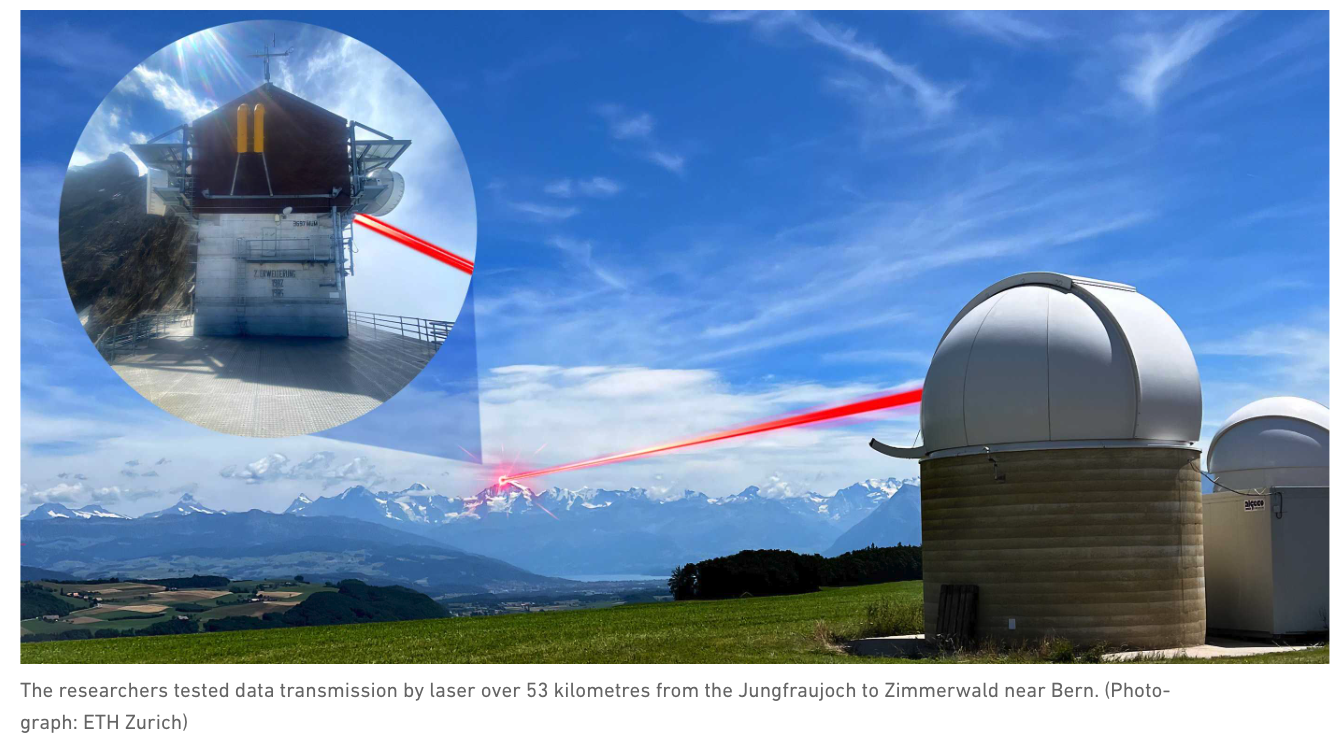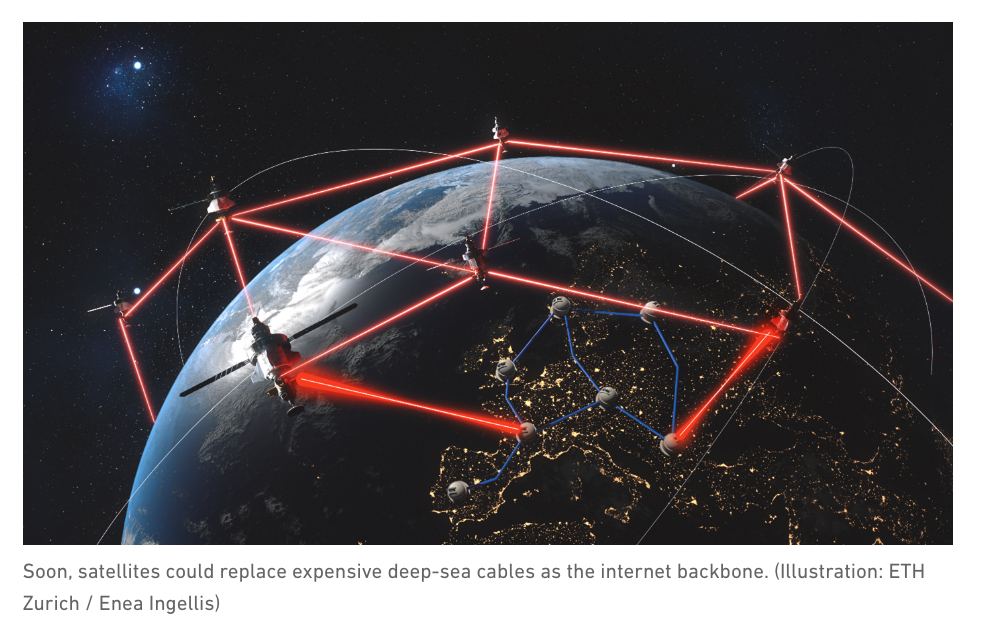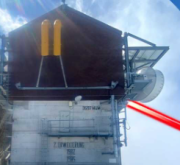日本語で読みたい方は、
google chromeで開いて、
画面上で右クリックをして
「日本語に翻訳」をクリックしてください
Optical data communications lasers can transmit several tens of terabits per second, despite a huge amount of disruptive air turbulence. ETH Zurich scientists and their European partners demonstrated this capacity with lasers between the mountain peak, Jungfraujoch, and the city of Bern in Switzerland. This will soon eliminate the necessity of expensive deep-sea cables.

In brief
- Scientists at ETH Zurich have demonstrated terabit optical data transmission through the air in a European Horizon 2020 project.
- The project partners tested their laser system not with a satellite in orbit, but through a transmission over 53 kilometres (33 miles) from the Jungfraujoch to Bern.
- In the future, this technology will make it possible to create backbone connections via near-Earth satellite constellations that are significantly less costly than deep-sea cables.
The backbone of the internet is formed by a dense network of fibre-optic cables, each of which transports up to more than 100 terabits of data per second (1 terabit = 1012 digital 1/0 signals) between the network nodes. The connections between continents take place via deep sea networks – which is an enormous expense: a single cable across the Atlantic requires an investment of hundreds of millions of dollars. TeleGeography, a specialised consulting firm, announced that there currently are 530 active undersea cables – and that number is on the rise.
Soon, however, this expense may drop substantially. Scientists at ETH Zurich, working together with partners from the space industry, have demonstrated terabit optical data transmission through the air in a European Horizon 2020 project. In the future, this will enable much more cost‑effective and much faster backbone connections via near-earth satellite constellations.
Challenging conditions between the Jungfraujoch and Bern
To achieve this milestone, the project partners took a significant leap forward in establishing a satellite optical communication link through a successful test conducted between the alpine mountain peak, Jungfraujoch, and the Swiss city of Bern. Although the laser system was not directly tested with an orbiting satellite, they accomplished high-data transmission over a free-space distance of 53km (33 miles). “For optical data transmission, our test route between the High Altitude Research Station on the Jungfraujoch and the Zimmerwald Observatory at the University of Bern is much more challenging than between a satellite and a ground station,” explains Yannik Horst, the study’s lead author and a researcher at ETH Zurich’s Institute of Electromagnetic Fields headed by Professor Jürg Leuthold.
The laser beam travels through the dense atmosphere near the ground. In the process, many factors – diverse turbulence in the air over the high snow-covered mountains, the water surface of Lake Thun, the densely built-up Thun metropolitan area and the Aare plane – influence the movement of the light waves and consequently also the transmission of data. The shimmering of the air, triggered by thermal phenomena, disturbs the uniform movement of light and can be seen on hot summer days by the naked eye.
Satellite internet uses slow microwave transmission
Internet connections via satellite are not anything new. The best-known example today is Elon Musk’s Starlink, a network of more than 2,000 satellites orbiting close to the Earth that provides internet access to virtually every corner of the world. However, transmitting data between satellites and ground stations uses radio technologies, which are considerably less powerful. Like a wireless local area network (WLAN) or mobile communications, such technologies operate in the microwave range of the spectrum and thus have wavelengths measuring several centimetres.
Laser optical systems, in contrast, operate in the near-infrared range with wavelengths of a few micrometres, which are about 10,000 times shorter. As a result, they can transport more information per unit of time.

To ensure a strong enough signal by the time it reaches a distant receiver, the laser’s parallel light waves are sent through a telescope that can measure several dozen centimetres in diameter. This wide beam of light must be precisely aimed at a receiving telescope with a diameter of the same order of magnitude as the width of the transmitted light beam upon arrival.
Turbulence cancels out modulated signals
To achieve the highest possible data rates, the laser’s light wave is modulated in such a way that a receiver can detect different states encoded onto a single symbol. This means each symbol transmits more than one bit of information. In practice, this involves different amplitudes and phase angles of the light wave. Each combination of phase angle and amplitude then forms a different information symbol that may be encoded into a transmitted symbol. Thus, with a scheme comprising 16 states (16 QAM), each oscillation can transmit 4 bits, and with a scheme comprising 64 states (64 QAM), 6 bits.
The fluctuating turbulence of the air particles results in varying speeds of light waves both within and at the edges of the light cone. As a result, when the light waves arrive at the detector of the receiving station, the amplitudes and phase angles either add together or cancel each other out, producing false values.
Mirrors correct wave phase 1,500 times per second
To prevent these errors, Paris-based project partner ONERA deployed a microelectromechanical system (MEMS) chip with a matrix of 97 tiny adjustable mirrors. The mirrors’ deformations correct the phase shift of the beam on its intersection surface along the currently measured gradient 1,500 times per second, ultimately improving the signals by a factor of about 500.
This improvement was essential in achieving a bandwidth of 1 terabit per second over a distance of 53 kilometres, Horst points out.
For the first time, new robust light modulation formats were demonstrated. This enabled a huge increase in detection sensitivity and thus high data rates, even under the worst weather conditions or at low laser power. This increase is achieved by cleverly encoding the information bits in properties of the light wave such as amplitude, phase and polarisation. “With our new 4D binary phase-shift keying, or BPSK, modulation format, an information bit can still be correctly detected at the receiver even with a very small number – about four – of light particles,” Horst explains.
All in all, the specific skills of three partners were needed for the project’s success. French space company, Thales Alenia Space is an expert in targeting lasers with centimetre accuracy over thousands of kilometres in space. ONERA, also French, is an aerospace research institute with expertise in MEMS-based adaptive optics, which has largely eliminated the effects of shimmering in the air. The most effective method of signal modulation, which is essential for high data rates, is a specialty of Leuthold’s ETH Zurich research group.
Easily expandable to 40 terabits per second
The results of the experiment, presented for the first time at the European Conference on Optical Communication (ECOC) in Basel is causing a sensation worldwide. Leuthold says, “Our system represents a breakthrough. Until now, only two options have been possible: connecting either large distances with small bandwidths of a few gigabits or short distances of a few metres with large bandwidths using free-space lasers.”
Moreover, the performance of 1 terabit per second was achieved with a single wavelength. In future practical applications, the system can be easily scaled up to 40 channels and thus to 40 terabits per second using standard technologies.
Additional potential for the new modulation format
However, scaling up is not something Leuthold and his team will be concerning themselves with; practical implementation of the concept in a marketable product will be carried out by the industry partners. Nevertheless, there is one part of the work that the ETH Zurich scientists will continue to pursue: In the future, the new modulation format they developed is likely to increase bandwidths in other data transmission methods where the energy of the beam can become a limiting factor.
Reference
Yannik Horst, Bertold Ian Bitachon, Laurenz Kulmer, Jannik Brun, Tobias Blatter, Jean-Marc Conan, Aurélie Montmerle-Bonnefois, Joseph Montri, Béatrice Sorrente, Caroline B. Lim, Nicolas Védrenne, Daniel Matter, Loann Pommarel, Benedikt Baeuerle and Juerg Leuthold. Tbit/s line-rate satellite feeder links enabled by coherent modulation and full-adaptive optics. Light: Science & Applications (2023) 12
DOI: https//doi.org/10.1038/s41377-023-01201-7
出典:
https://ethz.ch/en/news-and-events/eth-news/news/2023/06/lasers-enable-internet-backbone-via-satellite.html
In case of addition or removal of the article, please contact us as below:
info@symphotony.com
この情報へのアクセスはメンバーに限定されています。ログインしてください。メンバー登録は下記リンクをクリックしてください。

